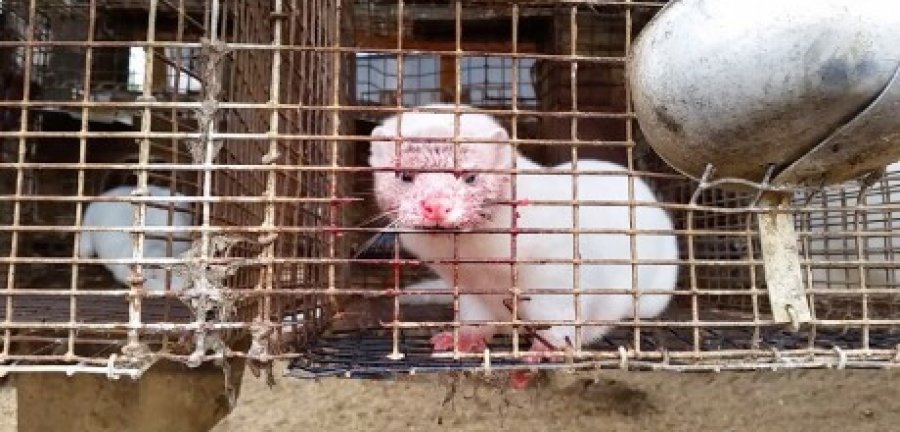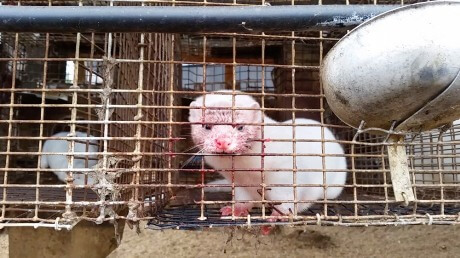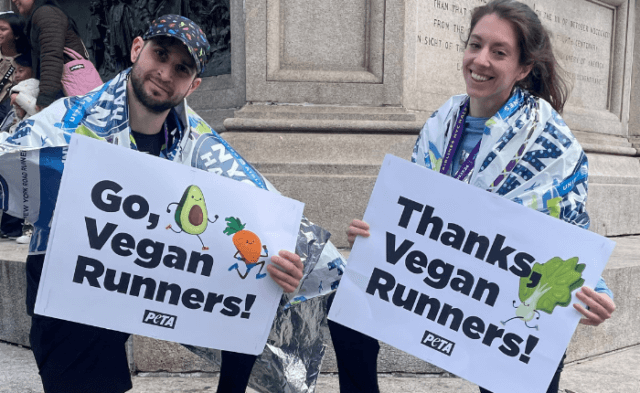Imagine if, right in front of you, terrified, screaming animals were grabbed by their sensitive tails, roughly crammed into a metal drum—as many as 30 at a time—and crudely suffocated with dirty gas from a running engine. They fight for their lives until the very end. It’s gruesome, and no one wants to think about such things—but if you wear real fur, you’re supporting cruelty like this.
Every time PETA or another PETA entity has investigated the fur trade, we’ve uncovered widespread suffering and abuse, and our latest case is no exception. The horrors we exposed once again confirm that fur farms around the world are designed to maximize profits—with little regard for animals’ well-being.
For two months, a PETA eyewitness documented the living hell for animals at Dillenburg Fur Farm in Wisconsin, the top mink-producing state in the U.S. At the time of the investigation, approximately 2,500 minks and 100 foxes at this farm were kept in rows of filthy, wire-floored cages not much bigger than their own bodies and situated directly above piles of their own waste—some a foot high—until they were slaughtered. The animals were given absolutely nothing to make their lives worth living.
Wild minks naturally spend much of their time in rivers and streams, but the minks on this farm had no access to water for bathing. Forced to live amid their own waste, their fur inevitably became filthy. So periodically, the cages were blasted with a high-pressure washer while they were still inside because, as one of the owners said, “If those mink are stained and dirty, I’m losing 10, 20 dollars a mink on that.”
The sound of the loud pressure-washer engine caused the animals to panic. One mink, named Miss Mary by PETA’s eyewitness, was so terrified that she chewed a hole through the cage wire, causing her mouth to bleed. The eyewitness did not see Miss Mary receive any veterinary care for her injuries, which isn’t uncommon in the fur industry.
In fact, minks were frequently found dead inside the cages.
Others ended up being gassed en masse. One mink survived this horror for more than 20 minutes before finally succumbing to carbon monoxide poisoning. When another survived the gassing, the farmer broke her neck.
There were also foxes on this farm, and one, named D2 by PETA’s eyewitness, had visibly swollen and inflamed gums. This was likely a very painful condition and may have made eating difficult. Like the other animals, D2 was killed in a makeshift gas chamber. Later, a worker told PETA’s observer that D2 had “put up a hell of a fight” as he was being killed.
With all the stylish, comfortable, warm vegan clothing available today, there’s no excuse for wearing another individual’s fur or skin. But right now, all over the world, animals are living in pain and fear—and being cruelly killed—just because humans want their fur coats for frivolous fashion. Even just the tiniest bit of fur trim on a collar or cuff came from an animal condemned to a lifetime of misery.
While many of the world’s problems might seem too overwhelming for us to tackle, solving this one is simple: Don’t buy or wear real fur. Choose clothing made from vegan faux fur or plant-based fabrics such as cotton, bamboo or Tencel blends—and refuse to support cruelty.
Dan Paden is an associate director in PETA’s Cruelty Investigations Department.






